2017_2018学年七年级英语下册现在进行时拔高课讲义(新版)人教新目标版
2017年人教版初中英语七年级英语下Unit6现在进行时公开课课件

(4)They want to go to the shop now. (want )
(5) — Are you waiting for your friends? (wait)
—No, I’m not.
考查现在进行时的结构。根据“直、去、双、变”原 则:watch-watching, wait-waiting。进行时的结构是be + v-ing。 (4)中表示某人的意愿,不用现在进行时。
Eg:
These days, uncle Wang is building a small room for
his dog.
这些天,李叔叔正在为他的狗建一个小房子。
考点大观易错辨析来自通关训练如何判断现在进行时
(4) 通过上下文句义,表明某一动作是现在或 说话瞬间发生的动作,这个句子也要用现在 进行时态。Eg: — Where is Tom? 汤姆在哪儿? — He is running on the playground .
能力要求
肯定 否定 疑问
标志词
变化 规则
考点大观
易错辨析
通关训练
现在进行时的结构
肯定 形式
主语 + be +doing sth.
Lily is doing her homework now.
否定 形式
主语 + be+ not doing sth.
Lily is not doing her homework now.
他正在操上想跑步。
考点大观
易错辨析
通关训练
如何判断现在进行时
(5) 某些动词的现在进行时,表示预定的计划
或即将发生的动作。
Eg:
(新人教版)新版学年七年级英语下册 现在进行时拔高课作业 (新版)人教新目标版【提分必备】

精品试卷家庭作业:现在进行时一、填空。
1.—Where is Jim?—He (lie) on the beach.2.Listen! They (sing) in the classroom.3.It’s six in the evening. She (eat) dinner.4.He (not watch) TV now.5.Be quite. Your grandpa_ (sleep) in the room. Heis tired.二、单选。
( )1. —What is Tom doing?—He baseball.A.is playing theB. playingC. is playingD. plays( )2. —Listen, they about Super Voice Girl. Let’s join them.— OK. Let’s go.A. are talkingB. have talkedC. talkD.talked ( )3. Look, the man is anewspaper.A. lookingB. looking atC. readingD. read( )4. —Shall we go out for a walk?—Sorry, I can’t. I _ my homework.A. am doingB. was doingC. doD. did( )5. —Where is your mother, Alice?—She the flowers in the garden.A. watersB. wateredC. is wateringD. has watered( )6. Mr. Green to the manager now. You’d better call him later.A. talkB. talkedC. is talkingD. was talking三.句式变换。
最新七年级英语下册 情态动词拔高课讲义 (新版)人教新目标版
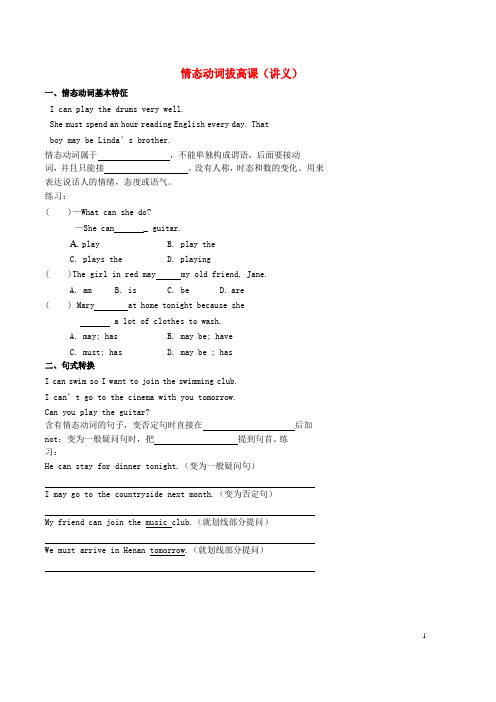
情态动词拔高课(讲义)一、情态动词基本特征I can play the drums very well.She must spend an hour reading English every day. Thatboy may be Linda’s brother.情态动词属于,不能单独构成谓语,后面要接动词,并且只能接。
没有人称,时态和数的变化。
用来表达说话人的情绪,态度或语气。
练习:( )—What can she do?—She can _ guitar.A.playB. play theC. plays theD. playing( )The girl in red may my old friend, Jane.A. amB. isC. beD. are( ) Mary at home tonight because shea lot of clothes to wash.A. may; hasB. may be; haveC. must; hasD. may be ; has二、句式转换I can swim so I want to join the swimming club.I can’t go to the cinema with you tomorrow.Can you play the guitar?含有情态动词的句子,变否定句时直接在后加not;变为一般疑问句时,把提到句首。
练习:He can stay for dinner tonight.(变为一般疑问句)I may go to the countryside next month.(变为否定句)My friend can join the music club.(就划线部分提问)We must arrive in Henan tomorrow.(就划线部分提问)三、情态动词总结can1.能够,会My sister can speak English quite well. But I can’t speak Englishat all.can 可以用来描述某人具有某种。
20172018学年七年级英语下册 情态动词拔高课讲义 新版人教新目标版
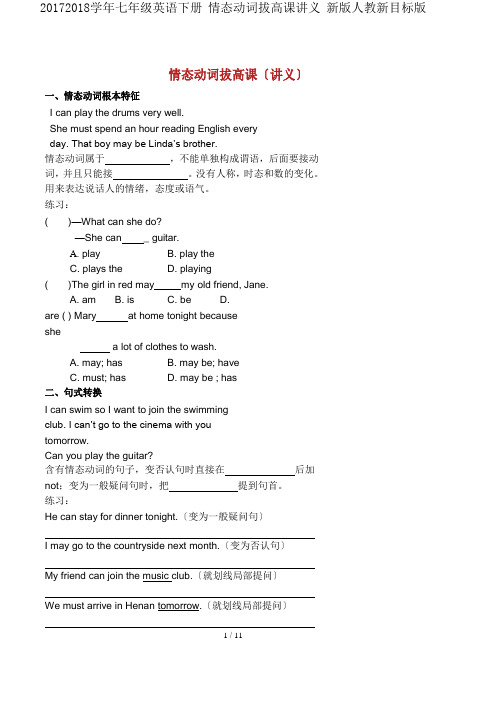
情态动词拔高课〔讲义〕一、情态动词根本特征I can play the drums very well.She must spend an hour reading English everyday. That boy may be Linda’s brother.情态动词属于,不能单独构成谓语,后面要接动词,并且只能接。
没有人称,时态和数的变化。
用来表达说话人的情绪,态度或语气。
练习:( )—What can she do?—She can _ guitar.A.playB. play theC. plays theD. playing( )The girl in red may my old friend, Jane.A. amB. isC. beD.are ( ) Mary at home tonight becauseshea lot of clothes to wash.A. may; hasB. may be; haveC. must; hasD. may be ; has二、句式转换I can swim so I want to join the swimmingclub. I can’t go to the cinema with youtomorrow.Can you play the guitar?含有情态动词的句子,变否认句时直接在后加not;变为一般疑问句时,把提到句首。
练习:He can stay for dinner tonight.〔变为一般疑问句〕I may go to the countryside next month.〔变为否认句〕My friend can join the music club.〔就划线局部提问〕We must arrive in Henan tomorrow.〔就划线局部提问〕1 / 11三、情态动词总结can1.能够,会My sister can speak English quite well. But I can’t speak English at all.can 可以用来描述某人具有某种。
七年级英语下册 现在进行时拔高课讲义 人教新目标版

现在进行时【key points】现在进行时——用法① 表示现在(说话瞬间)正在进行的动作②表示现阶段正在进行的动作现在进行时——构成构成: be + v-ing现在进行时——标志词现在: now,at the moment,look,listen,right now 现阶段:this month/ week,these days/ weeks / months 现在进行时——语境【exercise】一、填空1.Look! They (play) on the playground.2.Listen! The baby (cry).3.Shh! My sister (sleep). Don’t disturb her.4.—Where is Allan?—He (water) flowers in the garden.二、单选。
1.—Listen, they about I’m a Singer. Let’s join them.—OK. Let’s go.A.have talkedB. are talkingC. talkD. talked2.It’s eight o’clock. The students an English class.A.haveB. havingC. is havingD. are having3.The kite high in the sky now. It looks like a big bird.A.has flownB. is flyingC. was flyingD. flew4.—Allan, turn down the TV, please. I on the phone.—Oh, sorry.A.have talkedB. talkedC. am talkingD. talk精品现在进行时——句式变换Lucy is watching TV now.否定Lucy is not watching TV now.一般疑问—Is Lucy watching TV now?—Yes, she is. / No, she isn’t.特殊疑问What is Lucy doing now?【exercise】一、单选1.The old man is a newspaper.A.readB. looking atC. readingD. watching2.—What your family doing beside the lake?—They’re planting trees.A.isB. doesC. areD. can3.—are the foreigners doing now?—They’re doing Chinese Kung fu.A.WhatB. WhereC. WhenD. How4.—Is Xiaoqiang doing his homework?—.A.No, he doesn’tB. Yes, he isC. Yes, he doesD. Yes, he isn’t二、句式变换1.Kim is riding her new bike. (就划线提问)2.The children are singing on the hill. (就划线提问)精品3.Miss Yang is talking with Mr. Wu. (就划线提问)精品动词如何变现在分词形式 (-ing)直去双改1.直接加 ing2.去掉末尾不发音的 e 再加 ing3.以重读闭音节结尾的双写末位字母再加 ing4.以 ie 结尾的动词改 ie 为 y 再加 ing【小试牛刀】talkputhavedieclean现在进行表将来等特殊用法fly eat swim leave sleep1.有些动词用进行时(-ing)的外衣表示将来的含义,用以表达一个最近的计划或安排。
2017-2018学年度人教版新目标版七年级下册英语全册教案
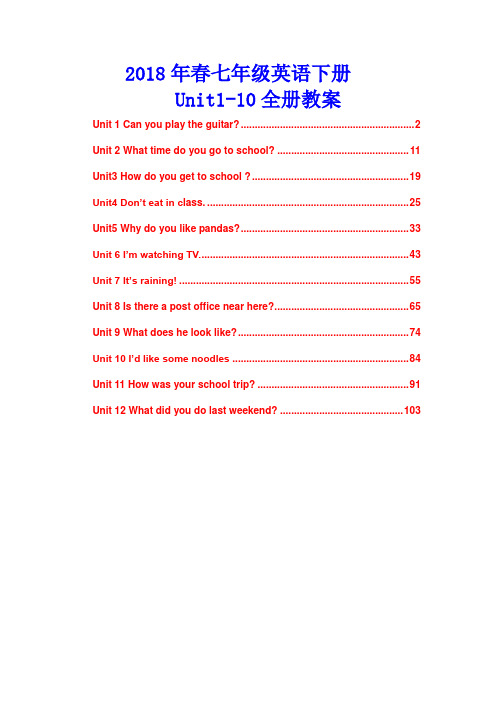
2018年春七年级英语下册Unit1-10全册教案Unit 1 Can you play the guitar? (2)Unit 2 What time do you go to school? (11)Unit3 How do you get to school ? (19)Unit4 Don’t eat in c lass. (25)Unit5 Why do you like pandas? (33)Unit 6 I’m watching TV (43)Unit 7 It’s raining! (55)Unit 8 Is there a post office near here? (65)Unit 9 What does he look like? (74)Unit 10 I’d like some noodles (84)Unit 11 How was your school trip? (91)Unit 12 What did you do last weekend? (103)2018年春七年级英语下册教案Unit 1 Can you play the guitar?一. Knowledge and abilities goals:1.vocabulary:dance,swim,sing,play chess , paint ,speak English, play the guitar2. How to use Model verb‖ can‖.3. Listening and speaking skills and communicative competence.二. Teaching method: Listening and speaking methods. Pair works.三. Moral goals: Encourage students to express their abilities.Content of courses: In this period, students will learn some names of clubs ,such as art , music, chess club, swimming club, etc. students will learn the drills :Do you want to join…club ?Can you …?四. Importance and difficulty: canTeaching Aids: A tape recorder. Some pictures. A projector Some sports things, such as volleyball, basketball, etc. Preparation test paper for lessons before class.五. Teaching Time: 4 periodsPeriod 1 (Section A: 1a-2d)授课人:______ 授课班级: _____ 授课时间:2016年___月___日____午第____节1.Knowledge Objects: Learn to talk about abilities.Know something about the culture of clubs. Can you/he..?What can you do? Whatc lub do you want to join?can, can‘t, draw, dance, swim, speak, walk.2.Teaching key point: can3. Teaching Difficult point: can4.Teaching Procedures:Step 1. Lead-inEnjoy a song I’m a musicianT: Do you want to be a musician? S:T: Can you play the p iano? S…T: What can you do? S: I can…T: What about you? S:T: OK, now please show your talent and tell us what you can do.Ask one of the students come to the front and do the action. Ask other students to guess what he or she can do.Step 2. PresentationT: Look at the pictures. What are they doing? S:Step 3 Pair workLook at the pictures. Ask and answer like this:A: Can you play basketball?B: Yes, I can. / No, I can‘t.Can you…?Step 4 PresentationShow some pictures of famo us stars. Practice the third person ―he, she, they‖T: Where can you play chess? S:T: Yes, in a chess club. This term, we have a lot of clubs. What club do you want to join? S…T: Sounds great. Can you…?S: Yes, I can/ No, I can‘tIf the answer is negative, guide students to say:S: No, I can‘t. But I can learn it from others.Step5 Pair workA: What club do you want to join?B: I want to join the…A: Can you …?B: Yes, I can . No, I can‘t. But I can learn it from others.Step 6 ListeningListen to 1bListen to 2a and 2b. Tell them to give special attention to listening activity (names of the clubs). Finish the tasks.Step 7 Pair workLook at 2b and talk about what the people can do the clubs they want to join.Step 7 Role-play the conversation 2dT: If you like telling stories. What club can you join?S: Story telling club.T: Right. Please read the conversation following the recording. Who wants to join the story telling club? Then role-play the conversation.Step 8 Explain some language points.Step 9 HomeworkReflection after class:_____________________________________________________________________ _____________________________________________________________________ _____________________________________________________________________ _________________________________Period 2 (Section A: 3a-3c)授课人:______ 授课班级: _____ 授课时间:2016年___月___日____午第____节1. Knowledge Objects: go on learning to talk about abilities.—Can you play the guitar? —Yes, I can./ No, I can't.—What can you do? —I can dance.—What club do you want to join? —I want to join the chess club.2. Teaching key points: Conclude the usage of ‗can‘; put all new language into practice through different activities.3. Teaching Difficult points: Distinguish ―say, speak, tell, talk‖4.Teaching Procedures:Step1:Greeting, Warming up and duty report.Watch a flash about the content of the Just for fun.Talk something about the flash: Why is the other boy unhappy?Introduce because of the difference of time zones, the time in different places are different.Revision: show the time in six places: Beijing, Tokyo, Paris, Los Angeles, New York, and London. Elicit the sentence pattern: What time is it?It‘s……Draw attention to the ―am‖ and ―pm‖. For instance, Beijing is seven o‘clock in the morning. We can say Beijing is seven am. Los Angeles is three in the afternoon. So we can say Los Angeles is three pm. (teacher helps students answer).Step2:Review the words learnt in the last period and add more.(1)T:Here are some Chinese, let us see what time do they usually get up/ take a shower…get up take a shower eat breakfast go to school eat lunch run go homedo homework eat dinner go to bed(2)ask students to make a surveyAsk your friend 5 questions about his /her day. Then make a report.A: What time do you usually…?B: I usually…at…Step3:presentation.(1)Ben‘s day. Introduce something about Ben.Using the sentence pattern: What time does he usually get up/go to school/…Pay attention to the verb form of the third person.Discuss Do you like ben‘;s routines.(2)Show the picture of Scott. He usually gets up at 5 pm.Ask students to predict what his job is?(3)listen to the tape,and try to answer this question. then read through the passage,and match the pictures with the times.(4)read it again and fill in the chart.(5)answer the following questions1.Where does he work?2.How does he go to work?Step4:Work on 3a.(1)Read through the passage and tell me what his job is.(2)Read it again and match the pictures.(3)Answer questions:What does he do after he get up?Does he go to work after breakfast? What does he do?How does he go to work? By bus or on foot?What does he do before he goes to bed?What does―What a funny time to eat breakfast!‖mean?Step5:Follow up.T:My friend Da Bao likes Scott's work, so he gets to Sai Te Hotel . But he doesn't find him.T: There are many children in the hotel. Look, they are coming. Please ask them questions to find the real Scott.Step6:Work on part4.T:Now six people make a group, and ask the other students when they usually go to bed . The leader lines up from the earliest to the latest bedtime.T: Let's listen Group1…Group2…Step7:Work on part 3 of self –check.T: Now I want to know something about what you do on weekends. You can go, ask your classmates and fill in the forms. Then you have a report.T: You may begin it like this "Ma Li gets up at …"Step8:Homework.Oral work:(1)Read 3a and recite it.(2)Go on making a survey to find out what your classmates do on weekends. Reflection after class:_____________________________________________________________________ _____________________________________________________________________ _____________________________________________________________________ _____________________________Period 3 (Section B: 1a-1f)授课人:______ 授课班级: _____ 授课时间:2016年___月___日____午第____节1. Knowledge Objects: go on learning to talk about abilities. drum, play the drum, piano, play the piano, violin, play the violin2. Teaching key points: Improve listening and speaking3. Teaching Difficult points: Improve listening and speaking4. Teaching Procedures:Step 1 Warming- up and revisionDaily greeting.Check the homework. Let some Ss report what his/her family members can do. Step 2 PresentationPlay the sound of different kinds of instruments. Let Ss guess what it is.Act and show your classmates your talent.T: Please stand in front of your classmates. Act and say what you can.S1: (sing and dance) I can sing and dance.S2: (play the drum) I can play the drum..Step 3 ListeningTell the Ss that they will listen to some sounds of the instruments. Listen and number the words [1-4] in the order of the sounds you hear in 1a.Play the recording again and check the answers.T: Now let's work on 1c. First, let one student read the words and phrases aloud. Then listen to the 1d and circle the words and phrase you hear.Check the answers:T: Now please look at the chart in 1e. What can Bill, Cindy and Frank do? What can't they do? You'll listen to the recording again. Then try to fill in the blanks.Step 4 Group workWork in groups. Take turn to talk about what Bill, Cindy and Frank can and can't do.S1: Bill can play the guitar, but he can't sing.S2: Cindy can sing and play the drum, but he can't play the piano.Teacher can walk around the classroom, and give some help to the Ss.Step 5 HomeworkMake up a conversation between a volunteer and a person who is in charge of a sports club/old people‘s home/music club.Reflection after class:_____________________________________________________________________ _____________________________________________________________________ _____________________________________________________________________ ____________________________________Period 4 (Section B: 2a-self check)授课人:______ 授课班级: _____ 授课时间:2016年___月___日____午第____节1. Knowledge Objects: go on learning to talk about abilities. also, people, help (sb) with sth, center, home, today, be good with, make, make friends, weekend, on weekends/on the weekend, teach, musician2. Teaching key points: Also, too; be good with, help with3. Teaching Dif ficult points: Describe one‘s ability4. Teaching Procedures:Step 1 Warming-upCheck the homeworkAsk some pairs to show their conversationsStep 2 ReadingFirst, show some pictures of the boys and girls and some key words in 2a.T: Here are some pictures and information about Peter, Alan and Ma Huan. Can you describe them according to the pictures and key words?S1: Guide Ss to use ―also, too‖, and distinguish how to use these two words.Give comments on Ss‘ descriptions.T: Now we‘ll read thre e ads. What's the main idea of each ad? What's each ad's title? Now let's read the three ads and select a title for each ad. Ss read carefully and try to select a title for each ad. Check the answers with the class.Step 3 Review the usage of “tell”,Re view and distinguish the usage and function of ―help‖T: Suppose Peter, Alan and Ma Huan want to help to do something after school. Which ad is right for him/her? Now read the descriptions in 2a and the ads in 2b again. Select a right ad for each person.Ss read the descriptions in 2a and the ads in 2b again. Try to select a right ad for each person. They can talk about the answers in their groups.Check the answers with the class.Step 4 Homework1. Recite 2a and 2b2. Finish the exercise on p6Reflection after class:____________________________________________________________________Unit 2 What time do you go to school?1. Teaching Aims:1) Aims of Basic Knowledge:①V ocabulary: time, shower, usually, O‘clock, what time, go to schoo l, take ashower.②Grammar: What time do you…? What time does he / she…?③ Function: Use the simple tense to talk about the daily life.2) Aims of Abilities: Listening skill. Speaking skill. Reading skill. Writing skill.3) Aims of Emotion: Love life.2. Analysis of the Material:1) Brief Introduction of the teaching material:What time / When do you…?‖ ― What time / When does he…?‖2) Teaching Focus: What time do you…? What time does he/ she…?3) Teaching Difficulties: Present tense.3. Learning Methods: Make a plan. Culture.4. Teaching Methods: Student- centered. Task-based Teaching.5. Teaching Time: 4 periodsPeriod 1(Section A: 1a-2a)授课人:______ 授课班级: _____ 授课时间:2016年___月___日____午第____节Step One: Warming-upGreetingT: Good afternoon, everyone.Ss: Good afternoon, Miss Yang.Step Two: Presentation1.Adjust the time, and ask students questions.T: What time is it? Ss: It‘s 12 o‘clock. ( Write on Bb )( Help Ss to say )T: What time is it? Ss: It‘s 10:15.( Help Ss to say )2.Ask one student to come to the front, adjust the time and ask the otherstudents.S1: What time is it? Ss: It‘s 9 o‘clock.3.Teach the new words & phrases.Show some pictures of different clocks and the activities.T: I‘m very busy these days. Can you guess what time I get up / eat breakfast / go to school / run / take a shower? ( Write on Bb)T: I usually get up at 6:35. ( Teach Ss the new word ― usually‖ )S1: You usually eat breakfast at …S2: You usually run at…S3: You usually take a shower at …4.Ask Ss to do the exercise of 1a, and then check the answers.Step Three: Listening1.Show Ss the timetable of Rick‘s ( write on small Bb )Rick‘s timetableGets upEats breakfastRunsGoes to schoolTakes a showerAsk Ss listen to the recorder and fill in the chart.Then check the answers.2.Ask and answer.T: What time does Rick get up / eat breakfast / run / go to school / take a shower ?Ss: He gets up / eats breakfast / runs / goes to school / takes a shower at…( Ask Ss pay attention to the underlined phrases.)Step Four: Consolidation1.Ask Ss to look at the pictures and tell their days.Example: I usually get up at …. I eat breakfast at …. I go to s chool at …. At …, I takea shower.Step Six: Homework1.Try to remember all the words & phrases.2.Survey: Ask your classmates their routines, and give your report.3.Plan: January 1st is coming. Please plan it, and make your day wonderful.Step Seven Blackboard DesignUnit 2What time do you go to school?What time do you go to school? I usually go to school at six thirty.go to school get dressed get up brush teetheat breakfast take a shower what timeReflection after class:_____________________________________________________________________ _____________________________________________________________________ _____________________________________________________________________ _______________________Period 2 (Section A: 2b-Grammar Focus)授课人:______ 授课班级: _____ 授课时间:2016年___月___日____午第____节1. Aims and demands :1) Language skills :Ss learn to talk about kinds of transportation, and how long it takes to go places, and how far apart places are.2) Target Language : Words : how far , get to , bicycle , subway , bus stop, train station , minute, kilometer, mile , transportation , calendarSentences: How do you get to school ? / How long does it take ? / How far is it ? 3) Moral object : Through learning this unit , Ss can enable them to care for each other whenever crossing the roads and pay attention to the sign of traffic.2. Analysis of the material:Students have learned the transportation before.. In this unit ,they need to learn more details about the transportation. At the same time ,they need to learn ―How long and How far‖ and they can use them freely.3. Teaching methods:pairwork , groupwork ,listening and speaking, practicing4, learning strategies:Personalizing Inferring vocabulary5.Teaching aids:Tape recorder, a projector or a computer6.Teaching period:Four periods.Period 3 (Section B: 3a-3c)授课人:______ 授课班级: _____ 授课时间:2016年___月___日____午第____节1. Aims and Demands: Key vocabulary, How do you get to school ? How does he getto school ?2. Teaching methods : Listening Writing Pairwork3. Teaching Aids : A tape recorder.Step I Leading inT: Good morning, everyone! You know I live far away ,so I go to school by bus every day. What about you? David, ―How often do you go to school?‖S:--------T: So we will talk about how to get to places in this unit.Step IINow I will show you pic tures and let‘s review the transportations we know. Then we will learn more about it .(take the subway) Please open your books and finish 1a. Step III1. There are five names in 1b.Now they are in the picture. We should find them.2. Play the tape .They should listen carefully and find the persons .Write the numbers next to the correct students in the picture above. After listening , check the answers together .Step IVPoint to the example in the box , ask two students to read it .then ask them to make up their conversations about how the people in the picture get to school .Teacher choose some pairs to act their conversations.Step VPracticing the listening :T: I will play two conversations The people are talking about how students get to school and how long it takes .The first time check the kinds of transportation that you hear. The second time match the time with the kinds of transportation activity 2a.Step VI1. Pay attention to the picture and dialogue.2. Make your own dialogue into pairs.3. Act it in front of the students.Step VIISummary and homework: This class we have learnt some key vocabulary and the target language .I hope after class you can survey how does your friends get to school .and pre-revise the 3a,3b.Step VIII Blackboard DesignUnit 4 How do you get to school ?How do you get to school ?How long does it take ?It takes about 10 minutes .Reflection after class:_____________________________________________________________________ _____________________________________________________________________ _____________________________________________________________________ __________________________________Period 4授课人:______ 授课班级: _____ 授课时间:2016年___月___日____午第____节课题Unit 2 What time do you go to school?(第4课时)教学批注教学设计一、教学三维目标1.知识与技能:(1)通过本单元的学习,使学生掌握相关的时间表达方法以及相关的词汇,能够就生活中的时间安排及日常活动来交谈;(2)通过情景设计来激发学生学习的学习兴趣,并培养学生的自主学习和与他人合作的精神;(3)通过谈论作息时间及日常活动,培养学生合理安排作息时间的意识。
(新人教版)新版学年七年级英语下册 代词拔高课讲义 (新版)人教新目标版【提分必备】
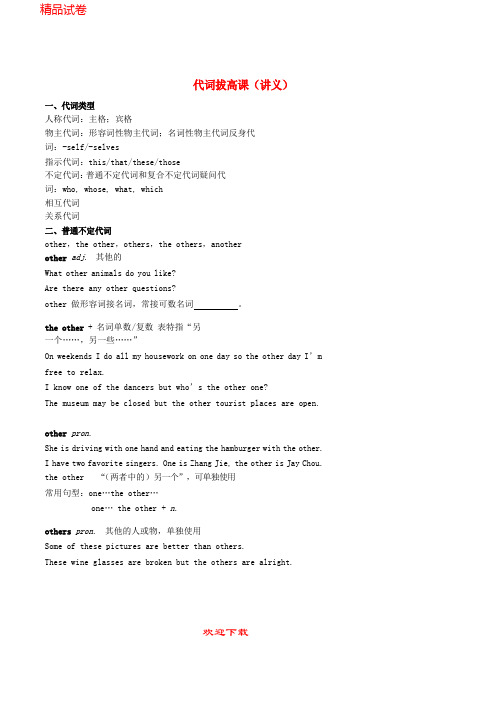
代词拔高课(讲义)一、代词类型人称代词:主格;宾格物主代词:形容词性物主代词;名词性物主代词反身代词:-self/-selves指示代词:this/that/these/those不定代词:普通不定代词和复合不定代词疑问代词:who, whose, what, which相互代词关系代词二、普通不定代词other,the other,others,the others,anotherother adj. 其他的What other animals do you like?Are there any other questions?other 做形容词接名词,常接可数名词。
the other + 名词单数/复数表特指“另一个……,另一些……”On weekends I do all my housework on one day so the other day I’m free to relax.I know one of the dancers but who’s the other one?The museum may be closed but the other tourist places are open.other pron.She is driving with one hand and eating the hamburger with the other.I have two favorite singers. One is Zhang Jie, the other is Jay Chou. the other “(两者中的)另一个”,可单独使用常用句型:one…the other…one… the other + n.others pron. 其他的人或物,单独使用Some of these pictures are better than others.These wine glasses are broken but the others are alright.欢迎下载the others 表特指,“剩余(的全部)”,单独使用My friends joined two clubs. Some joined the swimming club andjoined the art club.another 又一,另一,再一determiner 修饰名词,接可数名词单数Would you like another apple?We need another computer.The room is too small. Let’s see if they have another one.pron. 单独使用I don’t like this book. I am going to ask for another.总结可用作形容词修饰名词的:other,接可数名词复数another,接可数名词单数the other,接可数名词单数或者复数可用作代词单独使用的:the other,another 另一个人或物others,the others 其他的人或物练习:( )We have two foreign teachers here. One is from England, and is from America.A.anotherB. the otherC. otherD. the others( ) Some people like to rest in their free time. like to travel.A. OtherB. The othersC. OthersD. Another( )This cake is delicious! Can I have piece, please?A. otherB. anotherC. othersD. theother ( )Where are boys?A. the otherB. the othersC. othersD. another欢迎下载三、复合不定代词anyone (anybody)1.任何人,随便哪个人The exercises are so simple that almost anyone can do them.2.用于否定句和疑问句中,和 someone 的区别与 any,some 的区别相同Is anyone here?There isn’t anybody in the classroom.3.& everyone: all peopleThe police questioned everyone in the room.Everything in the shop is so good that I want to buy all of them. —What would you like to eat? —Anything is OK. 注意:复合不定代词做主语,谓语动词用单数。
现在进行时讲义-人教版七年级英语下册

语法:现在进行时的复习和练习巩固一、现在进行时态的概念:1、表示现在(说话瞬间)正在进行或发生的动作;2、还可表示当前一段时间内的活动或现阶段正在进行的动作。
例句:I am watching TV now and my sister Grace is doing her homework.我现在正在看电视,我的妹妹格蕾丝在做她的家庭作业。
又如:We are working on a farm these days. 这些天我们在农场上工作。
二、现在进行时的基本结构主语+ be + v. ing +其它三、动词现在分词的构成。
动词ing形式,又称为“动词的现在分词”构成规则如下:1、一般动词在词尾加ing;例如:go going ; play playing ; wash washing等。
2、以不发音的e结尾的动词,去e再加ing;例如:take taking ; drive driving ; ride riding ; exercise exercising ; make making.3、重读闭音节结尾的动词,双写最后一个辅音字母再加ing;例如:get getting ; begin beginning ; run running ; put putting ; sit sitting ; plan planning ; swim swimming ; shop shopping ; stop stopping ; cut cutting .4、特殊需要记忆的:tie tying ; lie lying ; die dying。
5、容易出错的词:see seeing.四、现在进行时的句型结构.1、肯定式:主语+ am / is / are + 动词ing +其他。
例如:We are having dinner at home happily. 我们正在家里高兴地吃着晚餐。
2、否定式:主语+ am / is / are + not + 动词ing + 其他。
2017_2018学年七年级英语下册综合复习讲义(新版)人教新目标版.doc
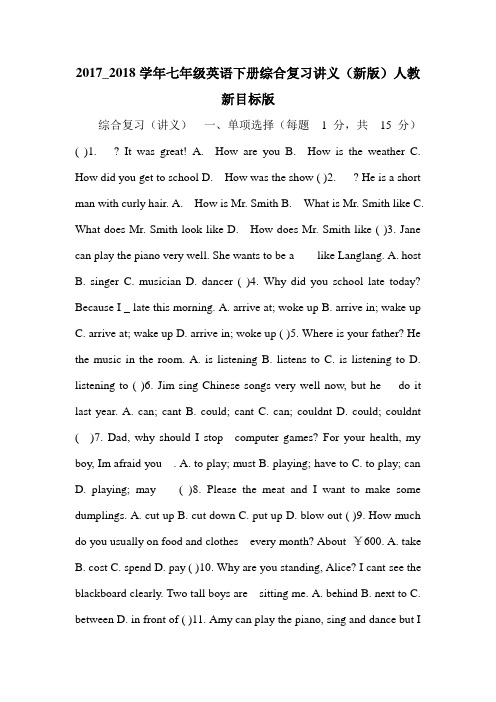
2017_2018学年七年级英语下册综合复习讲义(新版)人教新目标版综合复习(讲义)一、单项选择(每题 1 分,共15 分)( )1. ? It was great! A. How are you B. How is the weather C. How did you get to school D. How was the show ( )2. ? He is a short man with curly hair. A. How is Mr. Smith B. What is Mr. Smith like C. What does Mr. Smith look like D. How does Mr. Smith like ( )3. Jane can play the piano very well. She wants to be a like Langlang. A. host B. singer C. musician D. dancer ( )4. Why did you school late today? Because I _ late this morning. A. arrive at; woke up B. arrive in; wake up C. arrive at; wake up D. arrive in; woke up ( )5. Where is your father? He the music in the room. A. is listening B. listens to C. is listening to D. listening to ( )6. Jim sing Chinese songs very well now, but he do it last year. A. can; cant B. could; cant C. can; couldnt D. could; couldnt ( )7. Dad, why should I stop computer games? For your health, my boy, Im afraid you . A. to play; must B. playing; have to C. to play; can D. playing; may ( )8. Please the meat and I want to make some dumplings. A. cut up B. cut down C. put up D. blow out ( )9. How much do you usually on food and clothes every month? About ¥600. A. take B. cost C. spend D. pay ( )10. Why are you standing, Alice? I cant see the blackboard clearly. Two tall boys are sitting me. A. behind B. next to C. between D. in front of ( )11. Amy can play the piano, sing and dance but Icant do . A. any B. another C. other D. either ( )12. I have to do. Please give me A. something; anything B. nothing; something C. nothing; everything D. anything; nothing ( )13. Is there a No. 2 bus stop near here? to read. Yes, there is. at the second crossing, and you will find it. A. Turning left B. Turn left C. To turn left D. Turns left ( )14. it is today! A. How cold B. What cold C. How a cold D. What a cold ( )15. do you want to go to a movie? Lets go at 6:00. A. Where B. When C. Why D. How 二、完形填空(每题 1 分,共10 分)Jack arrived in a big city of China. When he got off the train, he felt very hungry ( 饥饿的) and wanted to 16 some food. But he didnt know 17 _ to get to a food shop, so he bought a 18 of the city. Jack read the map carefully. Then he walked along Heping Street and 19 right when he saw the traffic lights. But he was 20 . He didnt find any food shops there! Jack went to ask a policeman 21 help. He couldnt speak any Chinese, so he 22 a piece of paper and drew a food shop on it. The policeman was 23 and he knew what Jack wanted to do. He told Jack to go 24 the bridge and then walk on for about 25 . The food shop was next to a big hospital. Jack found the food shop at last. ( )16. A. bring B. catch C. make D. have ( )17. A. how B. what C. where D. when ( )18. A. map B. ticket C. photo D. calendar ( )19. A. moved B. stayed C. turned D. got ( )20. A. good B. bad C. right D. wrong ( )21. A. of B. for C. with D.from ( )22. A. put away C. put up B. came out D. took out ( )23. A. clever B. lucky C. interesting D. happy ( )24. A. past B. across C. through D. above ( )25. A. 100g B. 100 cm C. 100 m D. 100 km 三、阅读理解(每题 1 分,共20 分) A A Three boys, Tom, Sam and Jim bought seventeen apples. Tom wanted the half (一半). Sam wanted one-third (三分之一), and Jim wanted one-ninth (九分之一). But they didnt know how to do it. Just at that time, a little boy came with an apple in his hand. The boy said to them, Dont worry. Let me help you. Then he put his apple into their apples, and made the number of the apples eighteen. Then he gave Tom nine apples, he gave Sam six apples and he gave Jim two apples. He gave away seventeen apples and took his apple back. The three boys were very happy. And they said: How clever the boy is! 根据短文内容,选择正确的选项。
七年级英语下册 现在进行时拔高课讲义 (新版)人教新目标版
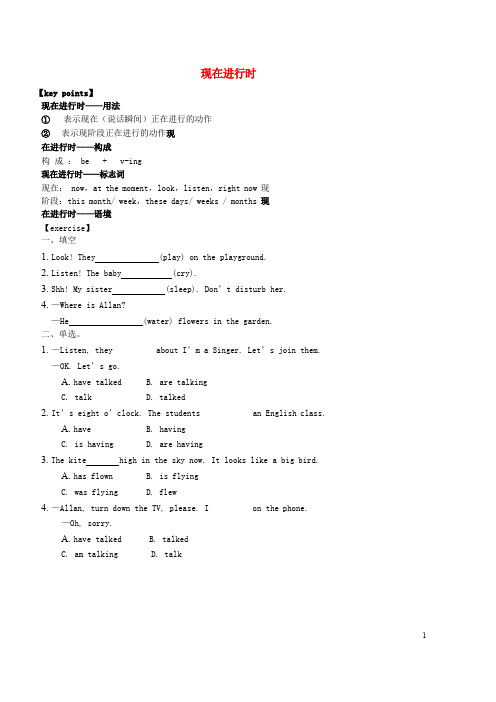
现在进行时【key points】现在进行时——用法① 表示现在(说话瞬间)正在进行的动作②表示现阶段正在进行的动作现在进行时——构成构成: be + v-ing现在进行时——标志词现在: now,at the moment,look,listen,right now 现阶段:this month/ week,these days/ weeks / months 现在进行时——语境【exercise】一、填空1.Look! They (play) on the playground.2.Listen! The baby (cry).3.Shh! My sister (sleep). Don’t disturb her.4.—Where is Allan?—He (water) flowers in the garden.二、单选。
1.—Listen, they about I’m a Singer. Let’s join them.—OK. Let’s go.A.have talkedB. are talkingC. talkD. talked2.It’s eight o’clock. The students an English class.A.haveB. havingC. is havingD. are having3.The kite high in the sky now. It looks like a big bird.A.has flownB. is flyingC. was flyingD. flew4.—Allan, turn down the TV, please. I on the phone.—Oh, sorry.A.have talkedB. talkedC. am talkingD. talk现在进行时——句式变换Lucy is watching TV now.否定Lucy is not watching TV now.一般疑问—Is Lucy watching TV now?—Yes, she is. / No, she isn’t.特殊疑问What is Lucy doing now?【exercise】一、单选1.The old man is a newspaper.A.readB. looking atC. readingD. watching2.—What your family doing beside the lake? —They’re planting trees.A.isB. doesC. areD. can3.—are the foreigners doing now?—They’re doing Chinese Kung fu.A.WhatB. WhereC. WhenD. How4.—Is Xiaoqiang doing his homework?—.A.No, he doesn’tB. Yes, he isC. Yes, he doesD. Yes, he isn’t二、句式变换1.Kim is riding her new bike. (就划线提问)2.The children are singing on the hill. (就划线提问)3.Miss Yang is talking with Mr. Wu. (就划线提问)动词如何变现在分词形式 (-ing)直去双改1.直接加 ing2.去掉末尾不发音的 e 再加 ing3.以重读闭音节结尾的双写末位字母再加 ing4.以 ie 结尾的动词改 ie 为 y 再加 ing 【小试牛刀】talkputhavedieclean现在进行表将来等特殊用法fly eat swim leave sleep1.有些动词用进行时(-ing)的外衣表示将来的含义,用以表达一个最近的计划或安排。
【精编】2017-2018学年七年级英语下册 代词拔高课讲义 新人教新目标版.doc
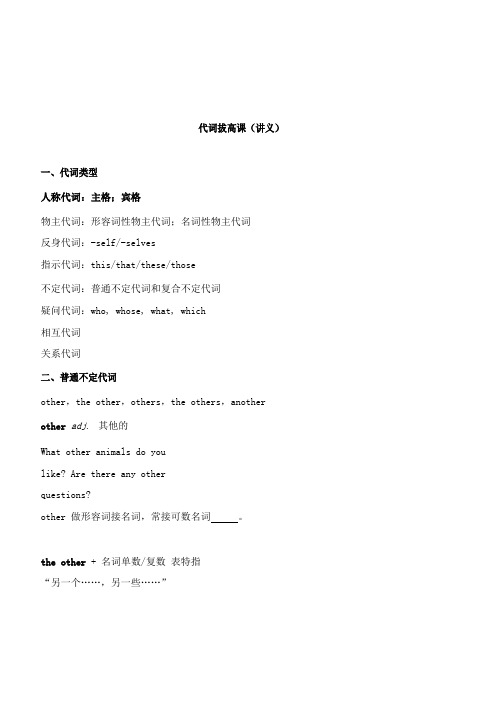
代词拔高课(讲义)一、代词类型人称代词:主格;宾格物主代词:形容词性物主代词;名词性物主代词反身代词:-self/-selves指示代词:this/that/these/those不定代词:普通不定代词和复合不定代词疑问代词:who, whose, what, which相互代词关系代词二、普通不定代词other,the other,others,the others,another other adj. 其他的What other animals do youlike? Are there any otherquestions?other 做形容词接名词,常接可数名词。
the other + 名词单数/复数表特指“另一个……,另一些……”On weekends I do all my housework on one day so the otherday I’m free to relax.I know one of the dancers but who’s the other one?The museum may be closed but the other tourist places are open.other pron.She is driving with one hand and eating the hamburger withthe other. I have two favorite singers. One is Zhang Jie,the other is Jay Chou. the other “(两者中的)另一个”,可单独使用常用句型:one…the other…one… the other + n.others pron. 其他的人或物,单独使用Some of these pictures are better than others.These wine glasses are broken but the others are alright.the others 表特指,“剩余(的全部)”,单独使用My friends joined two clubs. Some joined the swimming club andjoined the art club.another 又一,另一,再一determiner 修饰名词,接可数名词单数Would you like anotherapple? We need anothercomputer.The room is too small. Let’s see if they have another one.pron. 单独使用I don’t like this book. I am going to ask for another.总结可用作形容词修饰名词的:other,接可数名词复数another,接可数名词单数the other,接可数名词单数或者复数可用作代词单独使用的:the other,another 另一个人或物others,the others 其他的人或物练习:( )We have two foreign teachers here. One is from England, and is from America.A.anotherB. the otherC. otherD. the others( ) Some people like to rest in their free time. like to travel.A. OtherB. The othersC. OthersD. Another( )This cake is delicious! Can I have piece, please?A. otherB. anotherC. othersD. theother ( )Where areboys?A. the otherB. the othersC. othersD. another三、复合不定代词anyone (anybody)1.任何人,随便哪个人The exercises are so simple that almost anyone can do them.2.用于否定句和疑问句中,和 someone 的区别与 any,some 的区别相同Is anyone here?There isn’t anybody in the classroom.3.& everyone: all peopleThe police questioned everyone in the room.Everything in the shop is so good that I want to buy all of them. —What would you like to eat? —Anything is OK.注意:复合不定代词做主语,谓语动词用单数。
20172018学年七年级英语下册 现在进行时拔高课作业 新版人教新目标版
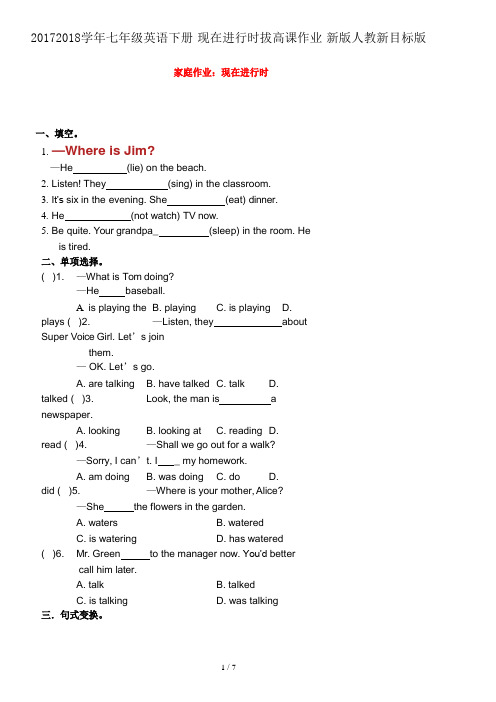
家庭作业:现在进行时一、填空。
1.—Where is Jim?—He (lie) on the beach.2. Listen! They (sing) in the classroom.3.It’s six in the evening. She (eat) dinner.4. He (not watch) TV now.5. Be quite. Your grandpa_ (sleep) in the room. Heis tired.二、单项选择。
( )1. —What is Tom doing?—He baseball.A.is playing theB. playingC. is playingD. plays( )2. —Listen, they about Super Voice Girl. Let’s jointhem.— OK. Let’s go.A. are talkingB. have talkedC. talkD. talked ( )3. Look, the man is a newspaper.A. lookingB. looking atC. readingD.read ( )4. —Shall we go out for a walk?—Sorry, I can’t. I _ my homework.A. am doingB. was doingC. doD.did ( )5. —Where is your mother, Alice?—She the flowers in the garden.A. watersB. wateredC. is wateringD. has watered( )6. Mr. Green to the manager now. You’d better call him later.A. talkB. talkedC. is talkingD. was talking三.句式变换。
- 1、下载文档前请自行甄别文档内容的完整性,平台不提供额外的编辑、内容补充、找答案等附加服务。
- 2、"仅部分预览"的文档,不可在线预览部分如存在完整性等问题,可反馈申请退款(可完整预览的文档不适用该条件!)。
- 3、如文档侵犯您的权益,请联系客服反馈,我们会尽快为您处理(人工客服工作时间:9:00-18:30)。
现在进行时
【key points】
现在进行时——用法
① 表示现在(说话瞬间)正在进行的动作
②表示现阶段正在进行的动作现
在进行时——构成
构成: be + v-ing
现在进行时——标志词
现在: now,at the moment,look,listen,right now 现
阶段:this month/ week,these days/ weeks / months 现
在进行时——语境
【exercise】
一、填空
1.Look! They (play) on the playground.
2.Listen! The baby (cry).
3.Shh! My sister (sleep). Don’t disturb her.
4.—Where is Allan?
—He (water) flowers in the garden.
二、单选。
1.—Listen, they about I’m a Singer. Let’s join them.
—OK. Let’s go.
A.have talked
B. are talking
C. talk
D. talked
2.It’s eight o’clock. The students an English class.
A.have
B. having
C. is having
D. are having
3.The kite high in the sky now. It looks like a big bird.
A.has flown
B. is flying
C. was flying
D. flew
4.—Allan, turn down the TV, please. I on the phone.
—Oh, sorry.
A.have talked
B. talked
C. am talking
D. talk
现在进行时——句式变换
Lucy is watching TV now.
否定
Lucy is not watching TV now.
一般疑问
—Is Lucy watching TV now?
—Yes, she is. / No, she isn’t.
特殊疑问
What is Lucy doing now?
【exercise】
一、单选
1.The old man is a newspaper.
A.read
B. looking at
C. reading
D. watching
2.—What your family doing beside the lake? —They’re planting trees.
A.is
B. does
C. are
D. can
3.—are the foreigners doing now?
—They’re doing Chinese Kung fu.
A.What
B. Where
C. When
D. How
4.—Is Xiaoqiang doing his homework?
—.
A.No, he doesn’t
B. Yes, he is
C. Yes, he does
D. Yes, he isn’t
二、句式变换
1.Kim is riding her new bike. (就划线提问)
2.The children are singing on the hill. (就划线提问)
3.Miss Yang is talking with Mr. Wu. (就划线提问)
动词如何变现在分词形式 (-ing)
直去双改
1.直接加 ing
2.去掉末尾不发音的 e 再加 ing
3.以重读闭音节结尾的双写末位字母再加 ing
4.以 ie 结尾的动词改 ie 为 y 再加 ing 【小试牛刀】
talk
put
have
die
clean
现在进行表将来等特殊用法fly eat swim leave sleep
1.有些动词用进行时(-ing)的外衣表示将来的含义,用以
表达一个最近的计划或安排。
2.现在进行时与always, forever 等词连用,表强烈的感情色彩。
Kim is
always helping others.
Allan is forever lying.
3.表示思想、感情、态度或状态的词一般不用现在进行时。
【综合训练】一
、填空
1.Listen! A girl (sing) in the classroom.
2.Tom (play) the piano in the
room. Please ask him to come here.
3.—Could you help me carry the heavy box?
—Sorry, I (wash)my clothes.
4.Look! The students (wait) for the school bus.
5.David usually (have) dinner at six. It’s seven
o’clock now. He (have) his meal.
二、单选
1.Look! The twins _ new sweaters.
A.are wearing
B. wearing
C. are wear
D. is wearing
2.—What’s your brother doing in his room now?
—He a model plane.
A.makes
B. made
C. is making
D. will make
3.Her father is . He a car now.
A.a driver; is driving
B. driver; drives
C. a driver; drive
D. driver; is driving
4.Listen! Lily the doll in the bedroom.
A.cut
B. is cutting
C. is cut
D. are cutting
5.—Please turn off the radio, grandpa now.
—OK, I’ll do it right now.
A.is sleeping
B. will sleep
C. slept
D. sleeps
6.—Be quiet! Where is Clark?
—He volleyball with his friends in the school gym.
A.plays
B. is playing
C. played
D. play
讲义参考答案
现在进行时的用法、构成、标志词
【exercise】
一、填空。
1.are playing
2. is crying
3.is sleeping
4.is watering
二、单选。
1—4:BDBC
现在进行时的句式变换
【exercise】一
、单选。
1—4
:CCAB
二、句式变换。
1.What is Kim doing?
2.Where are the children singing?
3.Who is Miss Yang talking with?
动词如何变现在分词形式 (-ing)
【小试牛刀】
talking flying
putting eating
having swimming
dying leaving
cleaning
sleepin
g
【综合训练】一
、填空。
1. is singing
2. is playing
3. am washing
4. are waiting
5. has ; is having
二、单选。
1—6:
ACABAB。
